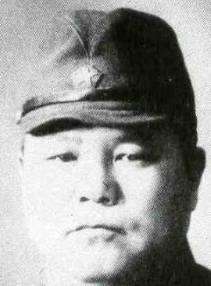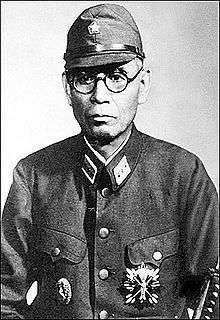Three Alls Policy
The Three Alls Policy (Chinese: 三光政策; pinyin: Sānguāng Zhèngcè, Japanese: 三光作戦 Sankō Sakusen) was a Japanese scorched earth policy adopted in China during World War II, the three "alls" being "kill all, burn all, loot all"[1] (Japanese: 殺し尽くし・焼き尽くし・奪い尽くす, Hepburn: koroshi tsukushi-yaki tsukushi-ubai tsukusu, Chinese: 殺光、燒光、搶光). This policy was designed as retaliation against the Chinese for the Communist-led Hundred Regiments Offensive in December 1940.[2] Contemporary Japanese documents referred to the policy as "The Burn to Ash Strategy" (燼滅作戦, Jinmetsu Sakusen).
The Chinese expression "Three Alls" was first popularized in Japan in 1957 when former Japanese soldiers released from the Fushun War Criminals Management Centre wrote a book called The Three Alls: Japanese Confessions of War Crimes in China (Japanese: 三光、日本人の中国における戦争犯罪の告白, Sankō, Nihonjin no Chūgoku ni okeru sensō hanzai no kokuhaku) (new edition: Kanki Haruo, 1979) in which Japanese veterans confessed to war crimes committed under the leadership of General Yasuji Okamura. The publishers were forced to stop the publication of the book after they had received death threats from Japanese militarists and ultranationalists.[3]
Description


The prototype of the Sankō Sakusen policy were the "annihilation campaigns" launched in late 1938 by the North China Area Army to "pacify" the Hepei province, which was a hotbed of guerrilla resistance.[4] The Showa Emperor gave his approval of the "annihilation campaign" in an order he signed on 2 December 1938.[5] The Imperial Japanese Army always saw the National Revolutionary Army and other forces loyal to the Kuomintang regime as their main enemy in China and tended to ignore the Chinese Communist forces, and by mid-1940, the Communists controlled vast tracts of the Chinese countryside, ruling over millions of people.[6] In August 1940, the Eighth Route Army (created from the Chinese Red Army) launched the "100 Regiments Campaign", an offensive targeting bridge, railroads, mines, blockade houses and telephone lines in northern China that caused extensive damage[7] In response to the "100 Regiments" offensive, General Ryūkichi Tanaka, commanding North China Area Army devised a plan for the "total annihilation" of the Communist base areas so that "the enemy could never use them again".[8]
Initiated in 1940 by Major General Ryūkichi Tanaka, the Sankō Sakusen was implemented in full scale in 1942 in north China by General Yasuji Okamura who divided the territory of five provinces (Hebei, Shandong, Shensi, Shanhsi, Chahaer) into "pacified", "semi-pacified" and "unpacified" areas.[9] The approval of the policy was given by Imperial General Headquarters Order Number 575 on 3 December 1941.[10] Okamura's strategy involved burning down villages, confiscating grain and mobilizing peasants to construct collective hamlets. It also centered on the digging of vast trench lines and the building of thousands of miles of containment walls and moats, watchtowers and roads to prevent guerrillas from moving around.[11] These operations targeted for destruction "enemies pretending to be local people" and "all males between the ages of fifteen and sixty whom we suspect to be enemies".[12]
In a study published in 1996, historian Mitsuyoshi Himeta claims that the Three Alls Policy, sanctioned by Emperor Hirohito himself, was both directly and indirectly responsible for the deaths of "more than 2.7 million" Chinese civilians. His works and those of Akira Fujiwara about the details of the operation were commented by Herbert P. Bix in his Hirohito and the Making of Modern Japan, who wrote that the Sankō Sakusen far surpassed the Rape of Nanking not only in terms of numbers, but in brutality as well as "These military operations caused death and suffering on a scale incomparably greater than the totally unplanned orgy of killing in Nanking, which later came to symbolize the war".[13] The effects of the Japanese strategy were further exacerbated by Chinese military tactics, which included the masking of military forces as civilians, or the use of civilians as deterrents against Japanese attacks. In some places, the Japanese also used chemical warfare against civilian populations in contravention of international agreements they refused to sign at the time.
Controversy and dispute
As with many aspects of Japan's World War II history, the nature and extent of Three Alls Policy is still a controversial issue. Because the now most well-known name for this strategy is in Chinese, some nationalist groups in Japan have even denied its veracity. The issue is partly confused by the fact that scorched-earth tactics were also used by the Kuomintang government forces in numerous areas of central and northern China, against both the invading Japanese, as well as against the Chinese civilian populations in rural areas where there was strong support for the Chinese Communist Party. Known in Japan as "The Clean Field Strategy" (清野作戦, Seiya Sakusen), Chinese soldiers would destroy the homes and fields of their own civilians in order to wipe out any possible supplies or places of shelter that could be utilised by the over-extended Japanese troops.[14] This similar military policy used in contested areas by the NRA affecting their own civilians greatly confuses matters.
In popular culture
The 2008 movie The Children of Huang Shi, which covers the Japanese invasion from 1938 to 1945, is set in part along the sankō sakusen.[15]
Notes
- Fairbank, J. K.; Goldman, M. (2006). China: A New History (2nd ed.). Harvard University Press. p. 320. ISBN 9780674018280.
- Grasso, June; Corrin, Jay; Kort, Michael. Modernization And Revolution In China: From the Opium Wars to World Power, pg. 129
- Herbert P. Bix, Hirohito and the Making of Modern Japan, HarperCollins, 2001, p. 657.
- Bix, Herbert Hirohito and the Making of Modern Japan, New York, Perennial, 2001 page 365
- Bix, Herbert Hirohito and the Making of Modern Japan, New York, Perennial, 2001 page 365
- Bix, Herbert Hirohito and the Making of Modern Japan, New York, Perennial, 2001 page 365
- Bix, Herbert Hirohito and the Making of Modern Japan, New York, Perennial, 2001 pages 365-366.
- Bix, Herbert Hirohito and the Making of Modern Japan, New York, Perennial, 2001 page 366
- Bix, Herbert Hirohito and the Making of Modern Japan, New York, Perennial, 2001 page 366
- Bix, Herbert Hirohito and the Making of Modern Japan, New York, Perennial, 2001 page 366
- Bix, Herbert Hirohito and the Making of Modern Japan, New York, Perennial, 2001 page 366
- Herbert Bix, Hirohito and the Making of Modern Japan, 2001, p. 365, citing an order drafted by Ryūkichi Tanaka.
- Bix, Herbert Hirohito and the Making of Modern Japan, New York, Perennial, 2001 page 365
- Harries. Soldiers of the Sun. page 235.
- "The Long March of a forgotten English Hero". The Times (London).
References
- Some of the content of this article comes from the equivalent Japanese-language article (accessed on April 7, 2006).
- Bix, Herbert P. Hirohito and the Making of Modern Japan. HarperCollins, 2000. ISBN 0-06-019314-X.
- Fujiwara, Akira (藤原彰). The Three Alls Policy and the Northern Chinese Regional Army (「三光作戦」と北支那方面軍), Kikan sensô sekinin kenkyû 20, 1998.
- Harries, Meirion (1994). Soldiers of the Sun: The Rise and Fall of the Imperial Japanese Army (Reprint ed.). New York: Random House. ISBN 0-679-75303-6.
- Himeta, Mitsuyoshi (1995). 日本軍による『三光政策・三光作戦をめぐって [Concerning the Three Alls Strategy/Three Alls Policy By the Japanese Forces] (in Japanese). Iwanami Bukkuretto. ISBN 978-4000033176.
